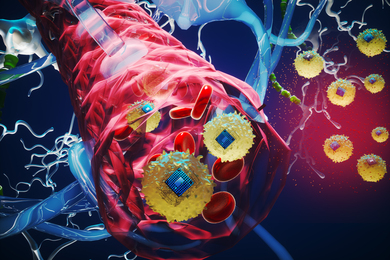Using short snippets of RNA to turn off a specific gene in certain immune cells, scientists have shown that they can shut off the inflammation responsible for diseases such as atherosclerosis.
This technique, known as RNA interference, offers a targeted way to stop inflammation and could be useful in treating not only atherosclerosis, but also other forms of heart disease as well as cancer, according to the researchers.
Since RNA interference was discovered in 1998, its ability to potentially shut off any gene in the body has intrigued scientists. RNA interference works by disrupting the flow of genetic information from a cell's nucleus to its protein-building machinery. The key to success is finding a safe and effective way to deliver short strands of RNA that can bind with and destroy messenger RNA, which carries instructions from the nucleus.
In a study appearing in the Oct. 9 issue of Nature Biotechnology, the researchers delivered short strands of RNA packaged in a layer of fat-like molecules called lipidoids. These RNA-delivering nanoparticles successfully reduced inflammation in mice, without side effects.
The research team includes MIT’s Daniel Anderson, associate professor in the Harvard-MIT Division of Health Sciences and Technology, and Institute Professor Robert Langer, as well as scientists from Massachusetts General Hospital, Harvard Medical School, Brigham and Women’s Hospital, Alnylam Pharmaceuticals, Harrison School of Pharmacy and Seoul National University in South Korea.
Too much of a good thing
Inflammation, a normal part of the body’s defenses against disease and injury, is necessary for wounds and infections to heal. However, too much inflammation can damage tissues. For example, a buildup of fat and cholesterol on artery walls produces inflammation that leads to atherosclerosis, a hardening of the arteries.
“After a short burst of inflammation, you want it to be dialed down. In disease, it continues to linger in the tissue and promote inflammation,” says Matthias Nahrendorf, assistant professor at the MGH Center for Systems Biology and Harvard Medical School and a senior author of the paper.
To turn down that response, the researchers targeted monocytes, a type of white blood cells attracted to sites of infection, where they stimulate inflammation.
Monocytes are recruited by a molecule called MCP1 that’s released at injury sites. MCP1 binds to a protein on the surface of monocytes called the CCR2 receptor, stimulating the cells to travel to the injury site and launch inflammation.
For this study, the researchers designed an RNA sequence that blocks the gene for the CCR2 receptor. Without that receptor, the monocytes do not respond to MCP1, so in theory, the treatment should block much of the inflammatory response.
Toning down inflammation
Indeed, when the researchers tested the RNA nanoparticles in mice with atherosclerosis and cancer, they found that inflammation was greatly reduced. Furthermore, tumors grew more slowly in the treated mice.
The scientists also found reduced inflammation when they treated mice that had recently had a heart attack. Such inflammation can contribute to subsequent heart failure.
Moreover, in mice that received transplanted pancreatic islet cells — a process that is being tested as an experimental therapy for Type 1 diabetes — the RNA treatment prolonged the survival of transplanted cells.
Delivering RNA specific to the CCR2 receptor avoids the side effects often seen with other anti-inflammatory drugs, Nahrendorf says, and allows other key immune cells to carry on with their normal functions.
This approach represents a good example of applying new technology to help solve a clinical problem, says Nikolaos Frangogiannis, a cardiologist and professor of medicine at Albert Einstein College of Medicine. “From a conceptual viewpoint, such a strategy could, if successful in humans, have a significant protective effect in patients following [a heart attack],” Frangogiannis says. However, he adds that much more extensive testing is needed before this technology could be used to treat heart disease or any other condition.
Anderson and Langer, who are both members of MIT’s David H. Koch Institute for Integrative Cancer Research, have developed similar nanoparticles to deliver RNA interference treatments for other diseases, including liver and ovarian cancers. “These kinds of approaches have a lot of potential for many different diseases,” Anderson says.
The researchers are now developing manufacturing techniques that could consistently yield large numbers of identical particles, which would be necessary for potential clinical trials.
A new way to curb inflammatory cells could lead to treatments for diseases including atherosclerosis and cancer.
Publication Date:

Credits:
Image: wikipedia/Vossman





